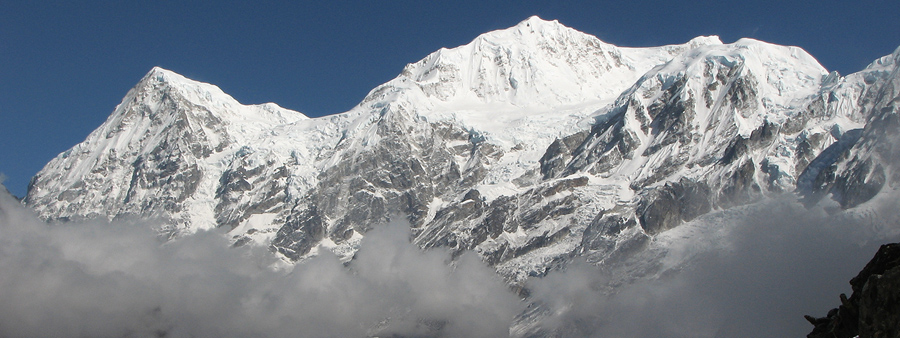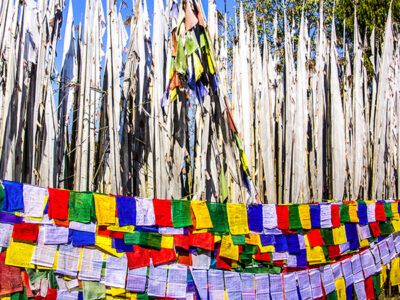Goecha La Trek – In The Shadow Of The Mighty Kanchenjunga

- Toy Train
- Spectacular views of the well-manicured tea gardens
- An 'off the beaten track'
- Magnificent high-level walking
- close encounter with the immense ice cliffs and snow fields of Kanchenjunga
- Tea plantations,
| Title | Goecha La Trek – In The Shadow Of The Mighty Kanchenjunga |
| Details | Delhi – Bagdogra – Darjeeling – Pelling – Yoksum – Sachen – Bakhim – Tshokha – Thamsing – Dzongri – Lamuney – Goecha La – Thamsing – Tshokha – Yoksum - Rumtek - Gangtok – Kalimpong – Bagdogra - Delhi |
| Duration | 18 Nights / 19 Days |
This Kangchenjunga trek begins at Yuksom, and the trail takes you through rhododendron forests to Dzongri, where you have a day to explore the stunning views of the surrounding area. The trek up to the Goecha La is scenically superb, with wonderful views of Mount Pandim and Kangchenjunga. It is a tough day’s walk up to the Goecha but one which is rich in rewards.
Sikkim is famous for Kangchenjunga (8,586m/28,169ft) the third highest mountain in the world, a rich flora and fauna and a diverse ethnic population. The original inhabitants, the Lepchas, call the region: Nye-mae-el: ('Paradise'). To the later Bhutias it is Beymul Denjong: ('The Hidden Valley of Rice'). The word ‘sikkim’ is commonly attributed to the Tsong word ‘sukkum’ meaning ‘new’ or ‘happy house’.
Sikkim is in the Eastern Himalaya, sandwiched between Nepal to its west, Bhutan to its east, Tibet to the north and to the south is the Indian state of West Bengal. It is the second smallest state in India (area 7,298 sq.km), only 112 km in length and 64 km wide; flat land is a rarity. Sikkim once covered a much larger area, but now begins at the foot of the mountains and is often referred to as 'the garden of the Himalaya'.
You will be assisted on arrival and transferred to your hotel for an overnight stay. In the afternoon you will proceed on a tour of Old Delhi to get a feel of the hustle and bustle of a vibrant city. The tour will include the Red Fort built by Emperor Shah Jahan; Jama Masjid, one of the largest mosques in India and enjoy a walking tour in Chandni Chowk - the silver street of Delhi bustling with activity. On your way back visit Raj Ghat - the samadhi of Mahatma Gandhi considered the Father of the Nation.
Today you will start your day by visiting the Botanical Garden situated at Shibpur area of Howrah District. Later visit the Howrah Bridge. It one of three bridges on the river Hooghly and is the most famous landmark in all of West Bengal. Visit the Dalhousie Square. Afternoon you will visit the Kali temple The Temple:
Day 03 : In Darjeeling – by flight To Darjeeling (2,165 m / 7,100 ft) – by surface / 88 km / approx 3 hrs
Today you have a delightful day in Darjeeling. You will have the opportunity to ride the Toy Train. It was a tiny four-wheeled trolley when it first rolled out. People, sacks of tea, bags of potatoes, wool from Tibet, Kalimpong oranges, jute and paddy stacks and more used to find space under its canvas roof and two quaint wooden benches.
In the afternoon you visit Happy Valley Tea Estate of about seventy tea gardens in this hilly region, this is one of the nearest, about 3 km from the town. Spectacular views of the well-manicured tea gardens and various towns in South and West Sikkim can be obtained along the way. Far down below the Ranjit River can be seen snaking its way through the mountains.
Today you will drive to Pelling a pleasant town situated on a ridge with fantastic views across to Kanchenjunga. Pelling also forms the base from where trekkers and other peripatetic adventurers undertake the strenuous and arduous treks in West Sikkim.
This little village is famous in Sikkimese history as the first king of Sikkim was crowned here. By the lake the stone throne where the king was crowned can be seen. From near the lake you can walk up the hill past fluttering prayer flags to a calm spot in the forests which bears the imprint of the Guru Rinpoche’s foot on one of the rocks.
Out of the hotel you walk gently uphill, following the Rathang river gorge, through dense, rich untouched forest with ferns and many different varieties of orchid and brightly coloured birds.. After about 4 hours, you’ll reach a swimming spot beside a waterfall (if you’re feeling brave!) and you can stop for lunch by a bridge over a stream.
Passing by sweet smelling viburnum, you cross the Prek Chu River before ascending steeply for two or three hours to arrive at the lodge at Bakhim. We stop for lunch here and then continue for another hour and a half through rhododendron forests climbing up to the deserted village of Tsokha where we camp tonight.
A fairly steep climb above Tshoka takes you into beautiful rhododendron forests and along a well-defined, uphill path to Phedung (about 2-3 hours from Tshoka) - a good lunch spot. A further climb of around 2 hours takes you to the trek lodges at Dzongri. A brief climb beyond brings you to a meadow where you can pitch camp in a site with views of Koktang 6,147m/20,167ft, Ratong, Kabru 7,338m/24,075ft, Kangchenjunga 8,586m/28,169ft, Simvo 6,815m/22,359ft and Pandim 6,691m/21,952ft. As usual on trek, the choice of campsite depends on many variables one of the most important being the proximity of water.
Today is a chance to explore the area and to climb the small peaks near to the campsite for tremendous views. This is particularly worth while in the early morning and the evening. While you can rest if you wish, there will be a short acclimatisation walk around the local area to help prepare you for the next few days.
Today you ascend gradually over open hillside for a mile or so to a low ridge visible from the camp site (4,115m/13,500ft). From here, beside some chortens on the skyline there are fabulous views of Kangchenjunga and Pandim.
Today’s walk to Lamuney is fairly short with plenty of opportunity to rest before tomorrow’s big day. Samati Lake is beautiful, holy and emerald green nestling behind brightly coloured, wind-torn prayer flags.
An alpine start today, setting off in the early morning to climb the hill behind the lake, before traversing the moraine to descend to the sandy bed of an empty lake. The whole area above Samati Lake is called the Chemithang Plateau. There are stupendous views of the east flank of Kangchenjunga as well as mountains and valleys in the distance.
It’s worth getting up early to make the short hike to the ridge behind camp. From here there are fantastic views of Kangchenjunga and one can look back up to the Goecha La.
Today you descend steeply back down to the Prek Chu River, following the route taken on the first day, and then contour gradually downwards to reach the village of Yuksom, the starting point.
Today you will drive to Gangtok, the capital of Sikkim. Enroute visit Rumtek Monastery, which is perched on a hilltop facing the city of Gangtok. 15 minutes’ walk downhill from the Main Monastery takes one to the Old Rumtek Monastery.
Day 16 : In Gangtok
In Gangtok visit Enchey Monastery, Lama Druptob Karpo is supposed to have built a small hermitage at this spot after he flew here from Maenam Hill more than two hundred years ago
The other places of interest during your day in Gangtok are - Government Institute of Cottage Industries: This centre offers you the opportunity to observe the local artisans at work and their skills being imparted to young boys and girls. Do-Drul Chorten: One of the most important Stupas of Sikkim built by the late Venerable Trulsi Rimpoche in 1945-46. Research Institute of Tibetology: Situated close to the Chorten this institute is a repository of the largest collection of Tibetan artifacts outside Tibet. Also renowned worldwide for the study of Buddhist philosophy and religion, it is a treasure house of rare thankas, Buddhist icon and objects of art.
Day 17 : To Kalimpong (1,200 m / 3,936 ft) - by surface / 72 km / approx 2 ½ hrs
After breakfast you will drive to Kalimpong, which is nestled in the foothills of the Himalaya. Kalimpong in local dialect means “black spur”. You will have a guided tour of Holumba - two acres of natural landscaped botanical extravaganza, water fed by a natural spring, inhabited by a flora population over 1000 species of orchids, plants & trees. Holumba offers the nature loving tourists an expansive orchid nursery.
This will be followed by a visit to a flower nursery. Also visit Gangjong Paper Industry renowned for the craft of paper making, which is an ancient tradition in the Himalayan region. The handmade paper that is being manufactured here still uses traditional tools and a special bamboo made screen is used to form the paper sheets.
After breakfast drive to Bagdogra in time to board your flight for Delhi / Kolkatta.
In time transfer to the International Airport to board your flight for home / onward journey.



